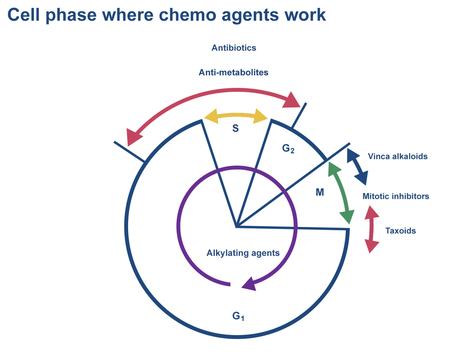The Cell Reproductive Cycle and Cytotoxic Drugs
Understanding how cells divide can help us understand how cytotoxic chemotherapy drugs work.
Both normal healthy cells and malignant cells reproduce in a process called mitosis. The chromosomes in the cell nucleus build copies of themselves and the nucleus splits followed by splitting of the cytoplasm. Two daughter cells are the result.
Cells are either interphase or mitotic phase at any given time. Most of the time cells are interphase – they are not reproducing. Different types of cells divide at different rates. The mitotic phase can be further divided to mitosis proper (division of the cell nucleus) and cytokinesis (division of the cytoplasm).
The whole cycle of somatic cell division typically lasts from 8 to 24 hours in humans. About 90 percent of the cell’s time is spent in interphase. Some cells rarely reproduce and the time scale is much longer.
Biologists who study cancer call out four phases in cellular reproduction: the G1, S, G2, and M phases. The cell progresses through these phases in order. Cell-cycle specific chemo agents act in one (or two) parts of the cycle. Cell-cycle nonspecific agents are active in all phases.

G1 is when the cell is doing its normal living. (G designates “Gap”.) Most protein production happens in this phase. The DNA is coiled up and not being replicated. S stands for synthesis; it is in the S phase is that DNA is copied. G2 is when RNA is replicated. M stands for mitosis – when the cell divides. Within the M phase are two sub-phases: Mitosis and Cytokinesis. Mitosis refers to division of the nucleus which is where the genetic material is housed. This means the new DNA strands separate from the original. At the end of the Mitosis sub-phase there are two nucleii in the same cell membrane. Cytokinesis (“cell motion”) immediately follows; it is division of the cytoplasm and formation of two separate daughter cells. The Mitosis phase can also be divided into these classifications: prophase (DNA lines up for replication), metaphase (formal replication), anaphase (split of chromosomes), and telophase (cell membrane closes so two cells are produced).
Cytotoxic drugs used to treat cancer usually work in the cell reproduction process. Some are designated cell-cycle specific (CCS) drugs that interfere in one phase of the process. Taxanes and vinca alkaloids do their biochemical work in the M phase. Antibiotics, PARP inhibitors, and antimetabolites work in the S phase.
When formulating combination chemotherapy regimens, oncologists often look for two drugs that work in different parts of the cycle.
Other chemotherapeutic agents kill multiplying cells in all phases. They are not phase-specific and are sometimes called CCNS, cell-cycle non-specific. Alkylating agents can work in any phase.
Enzymes called cyclin-dependent kinases are part of the biochemical process involved in starting the cycle, and in moving from G1 to S and from G2 to M. By inhibiting these kinases, some drugs are able to slow or stop cell proliferation. Several CDK-inhibitors are in use for cancer treatment.
Quantitative characteristics that can be used to describe tumors include:
Mitotic Index (MI): proportion of cells in mitosis
Labeling Index (LI): proportion of cells in S phase
Growth fraction: ratio of the number of cells number of cells proliferating cells to the total number of cells. This fraction is typically 30 percent to 50 percent.
Biochemists have determined certain medicines work in these phases:
M-phase drugs
Vinblastine
Vincristine
Vinorelbine
Cabazitaxel
Docetaxel
Paclitaxel
Eribulin
Estramustine
Ixabepilone
S-phase drugs
Methotrexate
Pemetrexed
Pralatrexate
Cytarabine
Gemcitabine
Clofarabine
Fludarabine
Mercaptopurine
Nelarabine
Pentostatin
Thioguanine
Azacitidine
Decitabine
Irinotecan
Teniposide
G2-phase drugs
Epirubicin
Bleomycin
Cabazitaxel
Docetaxel
Paclitaxel
Eribulin
Ixabepilone
Etoposide
Teniposide
G1-phase drugs
Mitomycin
Asparaginase
Pegaspargase